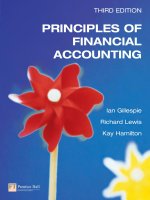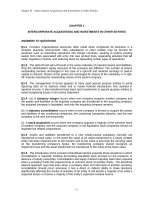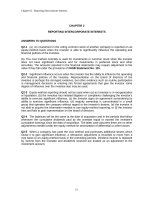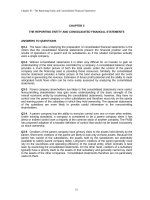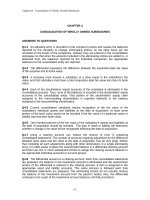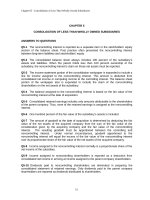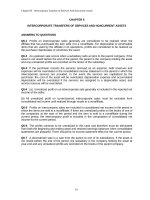Solution manual financial accounting 8th edition by libby libby and short chapter 10
Bạn đang xem bản rút gọn của tài liệu. Xem và tải ngay bản đầy đủ của tài liệu tại đây (546.54 KB, 43 trang )
Find more at www.downloadslide.com
Chapter 10 - Reporting and Interpreting Bonds
Chapter 10
Reporting and Interpreting Bonds
ANSWERS TO QUESTIONS
1.
A bond is a liability that may or may not be secured by a mortgage on specified
assets. Bonds usually are in denominations of $1,000 or $10,000, are transferable
by endorsement, and may be bought and sold daily by investors. A bond specifies
a maturity date and rate of interest that will be paid on the principal amount. Bonds
usually are issued to obtain cash for long-term asset acquisitions (operational
assets) and expansion of the entity.
2.
A bond indenture is an agreement drawn up by a company planning to sell a bond
issue. The indenture specifies the legal provisions of the bond issue such as
maturity date, rate of interest, date of interest payments, and any conversion
privileges. When a bond is sold, an investor receives a bond certificate (i.e., a
bond). All of the bond certificates for a single bond issue are identical in most
respects. That is, each certificate states the same maturity date, interest rate,
interest dates, and other provisions of the bond issue.
3.
Secured bonds are supported by a mortgage or pledge of specific assets as a
guarantee of payment. Secured bonds are designated on the basis of the type of
asset pledged, such as real estate mortgage bonds and equipment trust bonds.
Unsecured bonds are not supported by a mortgage or pledge of specific assets as
a guarantee of payment at maturity date. Unsecured bonds usually are called
debentures.
4.
Callable bonds—bonds that may be called for early retirement at the option of the
issuer.
Convertible bonds—bonds that may be converted to other securities of the issuer
(usually common stock) after a specified future date at the option of the
bondholder.
Financial Accounting, 8/e
10-1
© 2014 by McGraw-Hill Global Education Holdings, LLC. This is proprietary material solely for authorized instructor use. Not authorized for sale or distribution in
any manner. This document may not be copied, scanned, duplicated, forwarded, distributed, or posted on a website, in whole or part.
Find more at www.downloadslide.com
Chapter 10 - Reporting and Interpreting Bonds
5.
Several important advantages of bonds compared with capital stock benefit the
issuer. The issuance of bonds establishes a fixed amount of liability and a fixed rate
of interest on the bond, and interest payments to the bondholders are deductible on
the income tax return of the issuer. This deduction for tax purposes reduces the net
cost of borrowing. For example, a corporation with a 40% average tax rate and
bonds payable with a 10% interest rate would incur a net interest rate of 10% x
60% = 6%.
6.
The higher the tax rate is, the lower the net cost of borrowing money because the
interest paid on borrowed money is deductible on the income tax return of the
borrower. The higher the income tax rate the less the net cost of interest for the
borrower. For example, a corporation with an average tax rate of 40% and debt
with 10% interest per annum incurs a net interest rate of 10% x 60% = 6%. In
contrast, the same corporation with a 20% average tax rate incurs a net interest
rate of 10% x 80% = 8%.
7.
At the date of issuance, bonds are recorded at their current cash equivalent
amount; that is, the amount of cash received for the bonds when issued. The
recording is in conformity with the cost principle.
8.
When a bond is issued (sold) at its face amount, it is issued at par. In contrast,
when a bond is sold at an amount lower than the par amount, it is issued at a
discount, and conversely, when it is sold at a price above par, it is issued at a
premium. A bond will sell at a discount when the market, or effective, rate of
interest is higher than the stated rate of interest on the bond. In contrast, when the
market or effective rate of interest is lower than the stated rate, the bond will sell at
a premium. Discounts or premiums on bonds payable are adjustments to the
effective interest rate on the bonds. Therefore, the discount or premium is
amortized over the life of the bonds as an increase or decrease in the amount of
interest expense for each period.
9.
The stated rate of interest is the rate specified on a bond, whereas the effective
rate of interest is the market rate at which the bonds are selling currently.
10. When a bond is sold at par, the stated interest rate and the effective or market
interest rate are identical. When a bond is sold at a discount, the stated rate of
interest is lower than the effective rate of interest on the bond. In contrast, when a
bond is sold at a premium, the stated rate of interest is higher than the effective
rate of interest.
10-2
Solutions Manual
© 2014 by McGraw-Hill Global Education Holdings, LLC. This is proprietary material solely for authorized instructor use. Not authorized for sale or distribution in
any manner. This document may not be copied, scanned, duplicated, forwarded, distributed, or posted on a website, in whole or part.
Find more at www.downloadslide.com
Chapter 10 - Reporting and Interpreting Bonds
11. A bond issued at par will have a book or carrying value, or net liability, equal to the
par or principal of the bond. This amount should be reported as the carrying value
on each balance sheet date. When a bond is sold at a premium or discount, the
premium or discount must be amortized over the outstanding life of the bond. When
there is bond discount or premium, the par amount of the bond less the
unamortized discount, or plus the unamortized premium, must be reported on the
balance sheet as the net liability as follows:
Bonds payable ...................................... $100,000
Less: Unamortized discount ..................
12,000
Plus: Unamortized premium ..................
Book value (net liability) ........................ $ 88,000
$100,000
12,000
$112,000
12. The basic difference between straight-line amortization and effective-interest
amortization of bond discount and premium is that, under straight-line amortization,
an equal amount of premium or discount is amortized to interest expense each
period. Straight-line amortization per interest period is computed by dividing the
total amount of the premium or discount by the number of periods the bonds will be
outstanding. Under effective-interest amortization, the amount of premium or
discount amortized is different each period. Effective-interest amortization of bond
premium and discount correctly measures the current cash equivalent amount of
the bonds and the interest expense reported on the income statement based on the
issuance entry. It measures the amount of amortization by relating the market
(yield) rate to the net liability at the beginning of each period. For this reason
interest expense and the bond carrying value are measured on a present value
basis. The straight-line method can be used only when the results are not
materially different from the results of the effective-interest method.
ANSWERS TO MULTIPLE CHOICE
1. c)
6. b)
Financial Accounting, 8/e
2. c)
7. c)
3. b)
8. c)
4. d)
9. a)
5. c)
10. c)
10-3
© 2014 by McGraw-Hill Global Education Holdings, LLC. This is proprietary material solely for authorized instructor use. Not authorized for sale or distribution in
any manner. This document may not be copied, scanned, duplicated, forwarded, distributed, or posted on a website, in whole or part.
Find more at www.downloadslide.com
Chapter 10 - Reporting and Interpreting Bonds
Authors’ Recommended Solution Time
(Time in minutes)
Mini-exercises
No.
Time
1
5
2
5
3
5
4
5
5
5
6
5
7
5
8
5
9
5
10
5
11
5
12
5
Exercises
No.
Time
1
10
2
10
3
15
4
15
5
15
6
10
7
20
8
20
9
20
10
15
11
15
12
20
13
30
14
20
15
20
16
20
17
25
18
30
19
25
20
10
21
10
22
10
Problems
No.
Time
1
40
2
30
3
30
4
40
5
50
6
45
7
45
8
50
9
35
10
40
11
40
12
25
13
35
14
20
Alternate
Problems
No.
Time
1
20
2
30
3
35
4
40
5
40
6
35
Cases and
Projects
No.
Time
1
25
2
20
3
20
4
30
5
30
6
25
7
*
* Due to the nature of this project, it is very difficult to estimate the amount of time
students will need to complete the assignment. As with any open-ended project, it is
possible for students to devote a large amount of time to these assignments. While
students often benefit from the extra effort, we find that some become frustrated by the
perceived difficulty of the task. You can reduce student frustration and anxiety by
making your expectations clear. For example, when our goal is to sharpen research
skills, we devote class time to discussing research strategies. When we want the
students to focus on a real accounting issue, we offer suggestions about possible
companies or industries.
10-4
Solutions Manual
© 2014 by McGraw-Hill Global Education Holdings, LLC. This is proprietary material solely for authorized instructor use. Not authorized for sale or distribution in
any manner. This document may not be copied, scanned, duplicated, forwarded, distributed, or posted on a website, in whole or part.
Find more at www.downloadslide.com
Chapter 10 - Reporting and Interpreting Bonds
MINI-EXERCISES
M10–1.
1. Balance Sheet
2. Income Statement
3. Statement of Cash Flows
4. May be in notes
5. Not at all
6. May be in notes
M10–2.
Principal
$600,000 0.4564
=
$273,840
Interest
$ 24,000 13.5903
=
326,167
Issue Price
=
$600,007*
*Issue price should be exactly $600,000. The $7 difference is the result of
rounding the present value factors at four digits.
M10–3.
Principal
$900,000 0.4350
=
$391,500
Interest
$ 27,000 13.2944
=
358,949
Issue Price
=
$750,449
M10–4.
January 1, 2014:
Cash (+A) ............................................................................
Discount on Bonds Payable (+XL, -L) ..................................
Bonds Payable (+L) .........................................................
June 30, 2014:
Interest Expense (+E, -SE) ($940,000 11% 1/2) ...........
Discount on Bonds Payable (-XL, +L) ..............................
Cash (-A) ($1,000,000 10% 1/2) ...............................
Financial Accounting, 8/e
940,000
60,000
1,000,000
51,700
1,700
50,000
10-5
© 2014 by McGraw-Hill Global Education Holdings, LLC. This is proprietary material solely for authorized instructor use. Not authorized for sale or distribution in
any manner. This document may not be copied, scanned, duplicated, forwarded, distributed, or posted on a website, in whole or part.
Find more at www.downloadslide.com
Chapter 10 - Reporting and Interpreting Bonds
M10–5.
January 1, 2014:
Cash (+A) ............................................................................
Discount on Bonds Payable (+XL, -L) ..................................
Bonds Payable (+L) ..........................................................
June 30, 2014:
Interest Expense (+E, -SE) ..................................................
Discount on Bonds Payable (-XL, +L) ..............................
Cash (-A) ..........................................................................
580,000
20,000
600,000
31,000
1,000
30,000
M10–6.
Principal
$500,000 0.4564
=
$228,200
Interest
$ 25,000 13.5903
=
339,758
Issue Price
=
$567,958
M10–7.
January 1, 2014:
Cash (+A) ............................................................................
Premium on Bonds Payable (+L) .....................................
Bonds Payable (+L) .........................................................
December 31, 2014:
Interest Expense (+E, -SE) ..................................................
Premium on Bonds Payable (-L) ..........................................
Cash (-A) ..........................................................................
620,000
20,000
600,000
52,000
2,000
54,000
M10–8
January 1, 2014:
Cash (+A) ............................................................................
Premium on Bonds Payable (+L) .....................................
Bonds Payable (+L) .........................................................
December 31, 2014:
Interest Expense (+E, -SE) ($910,000 7%) .......................
Premium on Bonds Payable (-L) ..........................................
Cash (-A) ($850,000 8%)...............................................
10-6
910,000
60,000
850,000
63,700
4,300
68,000
Solutions Manual
© 2014 by McGraw-Hill Global Education Holdings, LLC. This is proprietary material solely for authorized instructor use. Not authorized for sale or distribution in
any manner. This document may not be copied, scanned, duplicated, forwarded, distributed, or posted on a website, in whole or part.
Find more at www.downloadslide.com
Chapter 10 - Reporting and Interpreting Bonds
M10–9.
The debt-to-equity ratio and times interest earned ratio are both measures of the
risk associated with using debt in the capital structure of a company. A company
could have a high debt-to-equity ratio with relatively little risk if it generated a high
level of stable earnings. On the other hand, a company with a low debt-to-equity
ratio might be risky if it was unable to earn any profits. For this reason, most
analysts look to the times interest earned ratio as a measure of a company’s
ability to meet its required interest payments.
M10–10.
If the interest rates fall after the issuance of a bond, the bond’s price will
increase. The company will report a loss on the debt retirement. On the balance
sheet, cash and bonds payable will decrease. On the income statement, a loss
would be recorded.
M10–11.
When a company issues a bond at a discount, the interest expense each period
will be more than the cash payment for the interest. When a company issues a
bond at a premium, the interest expense will be less than the cash payment for
the interest. Neither is affected by the method used to amortize the discount or
premium.
M10–12.
Cash paid to retire a bond would be reported in the financing activities section of
the Statement of Cash Flows while cash paid for interest payments would be
reported in the operating activities section.
Financial Accounting, 8/e
10-7
© 2014 by McGraw-Hill Global Education Holdings, LLC. This is proprietary material solely for authorized instructor use. Not authorized for sale or distribution in
any manner. This document may not be copied, scanned, duplicated, forwarded, distributed, or posted on a website, in whole or part.
Find more at www.downloadslide.com
Chapter 10 - Reporting and Interpreting Bonds
EXERCISES
E10–1.
1.
2.
3.
4.
5.
6.
7.
Bond principal, par value, or face value
Par value or face value
Face value or par value
Stated rate, coupon rate, or contract rate
Debenture
Callable bonds
Convertible bonds
E10–2.
The AT&T bonds have a coupon interest rate of 6.5%. If bonds with a $10,000 face
value were purchased, the issue price would be $8,950 and they would provide a cash
yield of 7.3%. A decline in value after issuance would have no impact on AT&T’s
financial statements.
E10–3.
CASE A:
$100,000 x 0.5835 ....................................................... $ 58,350
$8,000 x 5.2064 ...........................................................
41,651
Issue price (market and stated rate same) ................... $100,001 (at par; $1
rounding error)
CASE B:
$100,000 x 0.6651 ....................................................... $ 66,510
$8,000 x 5.5824 ...........................................................
44,659
Issue price (market rate less than stated rate) .............. $111,169 (at a premium)
CASE C:
$100,000 x 0.5470 ....................................................... $ 54,700
$8,000 x 5.0330 ...........................................................
40,264
Issue price (market rate more than stated rate) ............ $ 94,964 (at a discount)
10-8
Solutions Manual
© 2014 by McGraw-Hill Global Education Holdings, LLC. This is proprietary material solely for authorized instructor use. Not authorized for sale or distribution in
any manner. This document may not be copied, scanned, duplicated, forwarded, distributed, or posted on a website, in whole or part.
Find more at www.downloadslide.com
Chapter 10 - Reporting and Interpreting Bonds
E10–4.
CASE A:
$500,000 x 0.6730 ....................................................... $ 336,500
$15,000 x 16.3514 ....................................................... 245,271
Issue price (market rate less than stated rate) .............. $581,771 (at a premium)
CASE B:
$500,000 x 0.5537 .......................................................
$15,000 x 14.8775 .......................................................
Issue price (market rate and stated rate same) ............
CASE C:
$500,000 x 0.4350 .......................................................
$15,000 x 13.2944 .......................................................
Issue price (market rate more than stated rate) ............
$ 276,850
223,163
$500,013 (at par, $13
rounding error)
$ 217,500
199,416
$ 416,916 (at a discount)
E10–5.
Applied Technologies’ ratios look better than Innovative Solutions’ ratios.
Applied Technologies has a lower debt-to-equity ratio than Innovative Solutions.
This means that they have less debt in their capital structure, and therefore, are a
less leveraged company and have less risk than Innovative Solutions. Applied
Technologies’ times interest earned ratio is higher than the ratio for Innovative
Solutions. This also makes Applied Technologies a less risky company than
Innovative Solutions because Applied Technologies generates a larger amount of
income compared to its obligatory payments to creditors than Innovative
Solutions.
E10–6.
Computations:
Interest:
$250,000 x 6% x 1/2 =
Present value:
$250,000 x 0.6756
$ 7,500 x 8.1109
Issue price
Financial Accounting, 8/e
=
=
=
$7,500
168,900
60,832
$229,732
10-9
© 2014 by McGraw-Hill Global Education Holdings, LLC. This is proprietary material solely for authorized instructor use. Not authorized for sale or distribution in
any manner. This document may not be copied, scanned, duplicated, forwarded, distributed, or posted on a website, in whole or part.
Find more at www.downloadslide.com
Chapter 10 - Reporting and Interpreting Bonds
E10–7.
Computations:
Interest:
$750,000 x 8%
= $ 60,000
Present value:
$750,000 x 0.4224
$ 60,000 x 6.4177
Issue price
= 316,800
= 385,062
= $701,862
Req. 1
January 1:
Cash (+A) ............................................................................
Discount on Bonds Payable (+XL, -L) ..................................
Bonds Payable (+L) ..........................................................
701,862
48,138
750,000
Req. 2
December 31:
Interest Expense (+E, -SE) ..................................................
Discount on Bonds Payable (-XL, +L) ..............................
Cash (-A) ..........................................................................
64,814
4,814
60,000
Req. 3
December 31, 2014:
Income statement:
Interest expense
$ 64,814
Balance sheet:
Long-term Liabilities
Bonds payable
Less: Unamortized discount ($48,138 - $4,814)
$750,000
43,324
10-10
$706,676
Solutions Manual
© 2014 by McGraw-Hill Global Education Holdings, LLC. This is proprietary material solely for authorized instructor use. Not authorized for sale or distribution in
any manner. This document may not be copied, scanned, duplicated, forwarded, distributed, or posted on a website, in whole or part.
Find more at www.downloadslide.com
Chapter 10 - Reporting and Interpreting Bonds
E10–8.
Computations:
Interest:
$600,000 x 7.5% x 1/2
= $ 22,500
Present value:
$600,000 x 0.7168
$ 22,500 x 6.6638
Issue price
= 430,080
= 149,936
= $580,016
Req. 1
January 1:
Cash (+A) ............................................................................
Discount on Bonds Payable (+XL, -L) ..................................
Bonds Payable (+L) ..........................................................
580,016
19,984
600,000
Req. 2
June 30:
Interest Expense* (+E, -SE) ................................................
Discount on Bonds Payable (-XL, +L) ..............................
Cash (-A) ..........................................................................
24,651
2,151
22,500
*($580,016 x 8.5% x ½)
Req. 3
June 30, 2014:
Income statement:
Interest expense
$ 24,651
Balance sheet:
Long-term Liabilities
Bonds payable
Less: Unamortized discount ($19,984 – $2,151)
$600,000
17,833
Financial Accounting, 8/e
$582,167
10-11
© 2014 by McGraw-Hill Global Education Holdings, LLC. This is proprietary material solely for authorized instructor use. Not authorized for sale or distribution in
any manner. This document may not be copied, scanned, duplicated, forwarded, distributed, or posted on a website, in whole or part.
Find more at www.downloadslide.com
Chapter 10 - Reporting and Interpreting Bonds
E10–9.
Computations:
Interest:
$600,000 x 7.5% x 1/2
= $ 22,500
Present value:
$600,000 x 0.7168
$ 22,500 x 6.6638
Issue price
= 430,080
= 149,936
= $580,016
Req. 1
January 1:
Cash (+A) ............................................................................
Bonds Payable (+L) ..........................................................
580,016
580,016
Req. 2
June 30:
Interest Expense* (+E, -SE) ................................................
Bonds Payable (+L) .........................................................
Cash (-A) ..........................................................................
24,651
2,151
22,500
*($580,016 x 8.5% x ½)
Req. 3
June 30, 2014:
Income statement:
Interest expense
$ 24,651
Balance sheet:
Long-term Liabilities
Bonds payable
$582,167
10-12
Solutions Manual
© 2014 by McGraw-Hill Global Education Holdings, LLC. This is proprietary material solely for authorized instructor use. Not authorized for sale or distribution in
any manner. This document may not be copied, scanned, duplicated, forwarded, distributed, or posted on a website, in whole or part.
Find more at www.downloadslide.com
Chapter 10 - Reporting and Interpreting Bonds
E10–10.
Req. 1
Issue price:
1.
Par, $500,000 – Carrying value at end of 1 year, $481,100 = $18,900 (unamortized
discount for 9 remaining years).
2.
$18,900 9 years = $2,100 discount amortization per year (straight line).
3.
$481,100 – $2,100 = $279,000 issue price (discount $21,000).
Issuance entry:
Cash (+A) ............................................................................
Discount on bonds payable (+XL, -L) ...................................
Bonds payable (+L) ..........................................................
479,000
21,000
500,000
Req. 2
Coupon (stated interest) rate:
1.
Reported interest expense, $23,100 – Discount amortized, $2,100 = $21,000 (cash
interest).
2.
$21,000 ÷ $500,000 = 4.2% coupon (stated interest) rate.
Interest expense:
Interest expense (+E, -SE)................................................... 23,100
Discount on bonds payable ($21,000 ÷ 10 years) (-XL, +L)
Cash ($500,000 x 4.2%) (-A) ............................................
2,100
21,000
E10–11.
1.
Issue price: $948. Stated rate, 6%; effective or yield rate, 8% (both were given).
2.
Discount: $1,000 – $948 = $52.
3.
$1,000 x 6% = $60.
4.
2014, $76; 2015, $77; 2016, $79.
5.
Balance sheet:
2014
$ 964
2015
$ 981
2016
$1,000
6.
(immediately before retirement)
Effective-interest amortization was used.
Financial Accounting, 8/e
10-13
© 2014 by McGraw-Hill Global Education Holdings, LLC. This is proprietary material solely for authorized instructor use. Not authorized for sale or distribution in
any manner. This document may not be copied, scanned, duplicated, forwarded, distributed, or posted on a website, in whole or part.
Find more at www.downloadslide.com
Chapter 10 - Reporting and Interpreting Bonds
E10–11. (continued)
7.
(a) $1,000 x 6% = $60.
(b) $964 x 8% = $77 (rounded).
(c) $77 – $60 = $17.
(d) $964 + $17 = $981.
8.
Effective-interest amortization measures the amount of interest expense and net
liability for each period on a present value basis. The interest expense and related
amortization are based on the actual unpaid balance of the debt and the effective
interest rate. Straight-line amortization is an approximation that does not take
these factors into consideration. The effective-interest method is conceptually
preferable but the straight-line method is used widely in practice because of
computational simplicity and the materiality concept.
E10–12.
The effective interest rate for a bond is determined by market forces and not the
company. American was able to specify the coupon rate for the bonds which
determines the periodic interest payments. It appears that American intended to
sell the bonds close to par value which would be achieved by having a coupon rate
that was the same as the market rate. The market rate of interest continually
changes as the result of such factors as inflation expectations and the level of
business activity. It is virtually impossible to issue a bond at a point when the
coupon rate and the market rate are exactly the same.
E10–13.
Assuming that both companies offer the same business risk, many people might
prefer the bond that had the slightly higher yield which is Walt Disney at 9.5%. If
interest rates were to fall significantly, companies might decide to call their bonds
and issue new ones at a lower interest rate. In this case, a zero coupon bond offers
an extra margin of protection. A zero is sold at a deep discount (say 60% of par). It
would be very unusual to see a company call such a bond if it were callable at par.
In this case, the PepsiCo bond would be preferred.
Many people who are retired desire to have a steady income without engaging in
time-consuming transactions. These people would probably not want to buy a zero
coupon bond which paid interest only at maturity.
10-14
Solutions Manual
© 2014 by McGraw-Hill Global Education Holdings, LLC. This is proprietary material solely for authorized instructor use. Not authorized for sale or distribution in
any manner. This document may not be copied, scanned, duplicated, forwarded, distributed, or posted on a website, in whole or part.
Find more at www.downloadslide.com
Chapter 10 - Reporting and Interpreting Bonds
E10–14.
Computations:
Interest:
$1,400,000 x 8% x 1/2 =
Present value:
$1,400,000 x 0.7894
$ 56,000 x 7.0197
Issue price
$ 56,000
= 1,105,160
=
393,103
= $1,498,263
Req. 1
January 1:
Cash (+A) ............................................................................ 1,498,263
Premium on Bonds Payable (+L) .....................................
Bonds Payable (+L) .........................................................
98,263
1,400,000
Req. 2
June 30:
Interest Expense (+E, -SE) ..................................................
Premium on Bonds Payable (-L) ..........................................
Cash (-A) ..........................................................................
43,717
12,283
56,000
Req. 3
Balance sheet:
Long-term Liabilities
Bonds payable
Plus: Unamortized premium ($98,263 – $12,283)
Income statement:
Interest expense
Financial Accounting, 8/e
$1,400,000
85,980
$1,485,980
$43,717
10-15
© 2014 by McGraw-Hill Global Education Holdings, LLC. This is proprietary material solely for authorized instructor use. Not authorized for sale or distribution in
any manner. This document may not be copied, scanned, duplicated, forwarded, distributed, or posted on a website, in whole or part.
Find more at www.downloadslide.com
Chapter 10 - Reporting and Interpreting Bonds
E10–15.
Computations:
Interest:
$2,000,000 x 5%
= $ 100,000
Present value:
$2,000,000 x 0.4350
$ 100,000 x 13.2944
Issue price
=
870,000
= 1,329,440
= $2,199,440
Req. 1
January 1:
Cash (+A) ............................................................................ 2,199,440
Premium on Bonds Payable (+L) .....................................
Bonds Payable (+L) .........................................................
199,440
2,000,000
Req. 2
June 30:
Interest Expense (+E, -SE) ($2,199,440 x 4.25%) ..............
Premium on Bonds Payable (-L) ..........................................
Cash (-A) ..........................................................................
93,476
6,524
100,000
Req. 3
Balance sheet:
Long-term Liabilities
Bonds payable
Plus: Unamortized premium ($199,440 – $6,524)
Income statement:
Interest expense
10-16
$2,000,000
192,916
$2,192,916
$93,476
Solutions Manual
© 2014 by McGraw-Hill Global Education Holdings, LLC. This is proprietary material solely for authorized instructor use. Not authorized for sale or distribution in
any manner. This document may not be copied, scanned, duplicated, forwarded, distributed, or posted on a website, in whole or part.
Find more at www.downloadslide.com
Chapter 10 - Reporting and Interpreting Bonds
E10–16.
Computations:
Interest:
$2,000,000 x 5%
= $ 100,000
Present value:
$2,000,000 x 0.4350
$ 100,000 x 13.2944
Issue price
=
870,000
= 1,329,440
= $2,199,440
Req. 1
January 1:
Cash (+A) ............................................................................ 2,199,440
Bonds Payable (+L) .........................................................
2,199,440
Req. 2
June 30:
Interest Expense (+E, -SE) ($2,199,440 x 4.25%) ..............
Bonds Payable (-L) ..............................................................
Cash (-A) ..........................................................................
93,476
6,524
100,000
Req. 3
Balance sheet:
Long-term Liabilities
Bonds payable
Income statement:
Interest expense
Financial Accounting, 8/e
$2,192,916
$93,476
10-17
© 2014 by McGraw-Hill Global Education Holdings, LLC. This is proprietary material solely for authorized instructor use. Not authorized for sale or distribution in
any manner. This document may not be copied, scanned, duplicated, forwarded, distributed, or posted on a website, in whole or part.
Find more at www.downloadslide.com
Chapter 10 - Reporting and Interpreting Bonds
E10–17.
Req. 1
Date
1/1/2014
12/31/2014
12/31/2015
12/31/2016
Cash
Interest
Interest Expense
Premium
Amortization
$500
500
500
$10,278 x 4% = $411
$10,189 x 4% = $408
$10,097 x 4% = $404
$89
92
96
Net Liability
Balance
$10,278
10,189
10,097
10,001*
* $1 rounding error
Present value computation:
Principal:
$10,000 x .8890
Interest:
500 x 2.7751
Issue price
$ 8,890
1,388
$10,278
Req. 2
December 31:
Interest expense ...................
Bond liability………………….
2014
2015
2016
$411
$10,189
$408
$10,097
$404
$10,000*
*Immediately before repayment of principal
E10–18.
Req. 1
Cash is increased on the balance sheet. The statement of cash flows shows an
inflow from financing activities. Bonds payable and premium on bonds payable
are increased on the balance sheet. The debt-to-equity ratio will be higher.
January 1:
Cash (+A) ............................................................................
Premium on bonds payable (+L) ......................................
Bonds payable (+L) ..........................................................
376,774
Principal: $300,000 x .7441 ..................................................
Interest: $18,000 x 8.5302 ....................................................
Issue (sale) price ......................................................
10-18
76,774
300,000
$223,230
153,544
$376,774
Solutions Manual
© 2014 by McGraw-Hill Global Education Holdings, LLC. This is proprietary material solely for authorized instructor use. Not authorized for sale or distribution in
any manner. This document may not be copied, scanned, duplicated, forwarded, distributed, or posted on a website, in whole or part.
Find more at www.downloadslide.com
Chapter 10 - Reporting and Interpreting Bonds
E10–18. (continued)
Req. 2
The interest expense will be increased on the income statement and the cash will
be decreased on the balance sheet. The premium on bonds payable will be
decreased on the balance sheet. The debt-to-equity ratio will be decreased and
the times interest earned ratio will be lower.
December 31:
Interest expense (+E, -SE)...................................................
Premium on bonds payable ($76,774 10 periods) (-L) .......
Cash ($300,000 x 6%) (-A) ...............................................
10,323
7,677
18,000
Req. 3
December 31, 2014:
Balance Sheet:
Long-term Liabilities
Bonds Payable
Add: Unamortized premium ($76,774 - $7,677)
Financial Accounting, 8/e
$300,000
69,097
$369,097
10-19
© 2014 by McGraw-Hill Global Education Holdings, LLC. This is proprietary material solely for authorized instructor use. Not authorized for sale or distribution in
any manner. This document may not be copied, scanned, duplicated, forwarded, distributed, or posted on a website, in whole or part.
Find more at www.downloadslide.com
Chapter 10 - Reporting and Interpreting Bonds
E10–19.
Req. 1
Computations:
Interest:
$1,000,000 x 9%
= $90,000 ÷ 2 = $45,000
Present value
$ 1,000,000 x .4564
$ 45,000 x 13.5903
=
=
456,400
611,564
$ 1,067,964
June 30:
Cash (+A) ............................................................................
Bonds payable (+L) ..........................................................
Premium on bonds payable(+L) ......................................
1,067,964
1,000,000
67,964
Req. 2
The amortization of bond premium does not affect cash flows directly but does
result in cash payments for interest that are higher than reported interest expense
for the period.
E10–20.
Bonds payable (-L) ..............................................................
Loss on bond call (+Loss, -SE) ............................................
Cash (-A) ..........................................................................
10-20
1,000,000
50,000
1,050,000
Solutions Manual
© 2014 by McGraw-Hill Global Education Holdings, LLC. This is proprietary material solely for authorized instructor use. Not authorized for sale or distribution in
any manner. This document may not be copied, scanned, duplicated, forwarded, distributed, or posted on a website, in whole or part.
Find more at www.downloadslide.com
Chapter 10 - Reporting and Interpreting Bonds
E10–21.
Bonds payable (-L) ..............................................................
Loss on bond call (+Loss, -SE) ............................................
Discount on bonds payable (-XL,+ L) ...............................
Cash (-A) ..........................................................................
1,200,000
159,000
75,000
1,284,000
E10–22.
1. Impacts Statement of Cash Flows (SCF) : report $960,000 inflow in financing
section
2. Does not impact SCF
3. Impacts SCF : report $57,000 payment in operating activities section
4. Impacts SCF : report $915,000 payment in financing section
Financial Accounting, 8/e
10-21
© 2014 by McGraw-Hill Global Education Holdings, LLC. This is proprietary material solely for authorized instructor use. Not authorized for sale or distribution in
any manner. This document may not be copied, scanned, duplicated, forwarded, distributed, or posted on a website, in whole or part.
Find more at www.downloadslide.com
Chapter 10 - Reporting and Interpreting Bonds
PROBLEMS
P10–1.
Req. 1—Comparison of results:
Actual Results
Results with an Increase
in Debt and a Decrease in
Stockholders’ Equity
Item
(a)
(b)
(c)
(d)
(e)
(f)
(g)
Total debt ...............................................
Total assets ............................................
Total stockholders’ equity .......................
Interest expense (total at 9%) .................
Net income .............................................
Return on total assets .............................
Earnings available to stockholders:
(1) Amount..............................................
(2) Per share ..........................................
(3) Return on stockholders’ equity ..........
$ 40,000
360,000
320,000
3,600
70,280
20.2%
$90,000
360,000
270,000
8,100
67,130
20.2%
$ 70,280
3.06
22.0%
$ 67,130
3.73
24.9%
Computations:
(a)
Given
(b)
Given
(c)
Given
(d)
$90,000 x 9% = $8,100.
(e)
($300,000 – $196,000 – $8,100) = $95,900, pretax; $95,900 x (100% – 30%) =
$67,130.
(f)
$70,280 + [$3,600 x (100% – 30%) = $2,520] = $72,800; $72,800÷ $360,000 =
20.2%.
$67,130 + [$8,100 x (100% – 30%) = $5,670] = $72,800; $72,800÷ $360,000 =
20.2%.
(g–1) From Item (e)
(g–2) $70,280 23,000 shares = $3.06 EPS.
$67,130 18,000 shares = $3.73 EPS.
(g–3) $70,280 $320,000 = 22.0%.
$67,130 $270,000 = 24.9%.
10-22
Solutions Manual
© 2014 by McGraw-Hill Global Education Holdings, LLC. This is proprietary material solely for authorized instructor use. Not authorized for sale or distribution in
any manner. This document may not be copied, scanned, duplicated, forwarded, distributed, or posted on a website, in whole or part.
Find more at www.downloadslide.com
Chapter 10 - Reporting and Interpreting Bonds
P10–1. (continued)
Req. 2 Interpretation:
The recommendation provided higher financial leverage compared with actual
financial leverage. This increase in positive financial leverage was because the
company had a net of tax interest rate on debt that was lower than the return on
total assets. This increase is favorable to the stockholders because their potential
dividends (based on retained earnings) and total owners’ equity are much higher.
The disadvantage of higher debt is the cash required to pay interest and principal.
This company appears to have the potential for future success. Therefore, the
higher debt leverage seems advisable.
P10–2.
Req. 1
Interest:
$500,000 x 8%
Present value
$ 500,000 x .6756
$ 20,000 x 8.1109
Issue price
=
=
=
$
40,000 ÷ 2 = $20,000
337,800
162,218
$500,018
The exact present value is $500,000. The $18 difference is due to rounding the
present value factors at four digits.
Req. 2
June 30
2014
$20,000
Dec. 31
2014
$20,000
June 30
2014
$20,000
Dec. 31
2014
$20,000
2014
Bonds payable ....................................... $500,000
2015
$500,000
Interest expense ....................................
Req. 3
Cash paid ..............................................
Req. 4
Financial Accounting, 8/e
10-23
© 2014 by McGraw-Hill Global Education Holdings, LLC. This is proprietary material solely for authorized instructor use. Not authorized for sale or distribution in
any manner. This document may not be copied, scanned, duplicated, forwarded, distributed, or posted on a website, in whole or part.
Find more at www.downloadslide.com
Chapter 10 - Reporting and Interpreting Bonds
P10–3.
Case A
a. Cash received at issue .......................................... $500,000
b. Bond interest expense (pretax) .............................. $ 35,000
Case B Case C
$490,000 $515,000
$ 36,000 $ 33,500
c.
d.
e.
f.
$500,000 $500,000
9,000
13,500
$491,000 $513,500
Bonds payable, 7%................................................ $500,000
Unamortized discount (deduct) ** ..........................
Unamortized premium (add) ** ..............................
Net liability ............................................................. $500,000
**Balance in discount or premium account
(January 1, 2014) ...............................................
Amortization during 2014 ......................................
Unamortized balance on December 31, 2014 ....
g. Stated rate of interest (given) ................................
7%
$ 10,000 $
(1,000))
$ 9,000 $
7%
15,000
(1,500)
13,500
7%
P10–4.
Req. 1
December 31, 2014—Financial statements:
a.
b.
c.
d.
e.
f.
Interest expense .....................................
Bonds payable ........................................
Unamortized premium or discount ..........
Net liability ..............................................
Stated rate of interest .............................
Cash interest paid ..................................
10-24
Case A
At Par,
100
Case B
Case C
At 99
At 104
$ 10,000
$100,000
$ 10,100
$100,000
(900)
$ 99,100
10%
$ 10,000
$ 9,600
$100,000
3,600
$103,600
10%
$ 10,000
$100,000
10%
$ 10,000
Solutions Manual
© 2014 by McGraw-Hill Global Education Holdings, LLC. This is proprietary material solely for authorized instructor use. Not authorized for sale or distribution in
any manner. This document may not be copied, scanned, duplicated, forwarded, distributed, or posted on a website, in whole or part.
Find more at www.downloadslide.com
Chapter 10 - Reporting and Interpreting Bonds
P10–4. (continued)
Req. 2—Explanation of differences:
Item a, interest expense, is different (in this situation) from Item f, cash interest paid, by
the amount of any bond discount or premium amortized for the period. This divergence
reflects the fact that discount and premium are adjustments of interest expense
because of a difference between the market and stated interest rates at date of
issuance of bonds.
Req. 3
The letter should explain that most bonds pay a fixed rate of interest by contract. As
market interest rates change over time, the price of the bond changes. When the market
interest rates increase, the price of the bond will fall. When rates decrease, the bond
price will increase. A discount simply means that the bond is selling for less than par; a
premium occurs when the bond sells for more than par. There is no advantage to
purchasing a bond at a discount because all bonds will adjust in price to yield the
market rate of interest.
P10–5.
1.
Computation of the amount of the bond liability when issued:
$200,000 x .4632 = $92,640
$ 12,000 x 6.7101 =
80,521
Issue Price
$173,161
2.
Computation of interest expense recorded on December 31, 2014:
$173,161 x 8% = $13,853
3.
Managers are normally relatively indifferent between the straight-line and effectiveinterest methods. The two methods typically produce very similar financial results.
In such cases, most managers would select the method that is simpler to use,
which would be the straight-line method.
4.
Date
Debt-to-Equity
Times Interest Earned
Issue date
Increase
No effect
Interest payment date
Increase
Decrease
Financial Accounting, 8/e
10-25
© 2014 by McGraw-Hill Global Education Holdings, LLC. This is proprietary material solely for authorized instructor use. Not authorized for sale or distribution in
any manner. This document may not be copied, scanned, duplicated, forwarded, distributed, or posted on a website, in whole or part.

